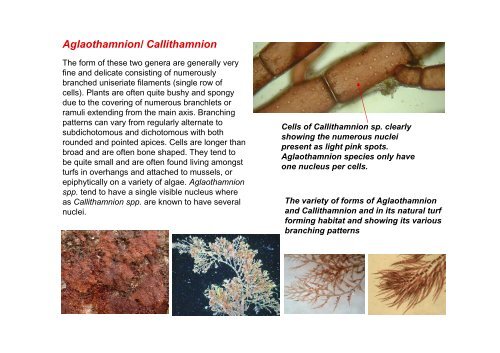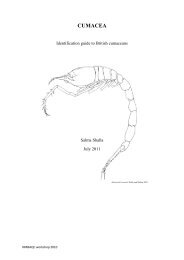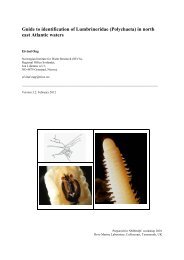s A Field Guide to the British Seaweeds - NMBAQC
s A Field Guide to the British Seaweeds - NMBAQC
s A Field Guide to the British Seaweeds - NMBAQC
Create successful ePaper yourself
Turn your PDF publications into a flip-book with our unique Google optimized e-Paper software.
Aglaothamnion/ Callithamnion<br />
The form of <strong>the</strong>se two genera are generally very<br />
fine and delicate consisting of numerously<br />
branched uniseriate filaments (single row of<br />
cells). Plants are often quite bushy and spongy<br />
due <strong>to</strong> <strong>the</strong> covering of numerous branchlets or<br />
ramuli extending from <strong>the</strong> main axis. Branching<br />
patterns can vary from regularly alternate <strong>to</strong><br />
subdicho<strong>to</strong>mous and dicho<strong>to</strong>mous with both<br />
rounded and pointed apices. Cells are longer than<br />
broad and are often bone shaped. They tend <strong>to</strong><br />
be quite small and are often found living amongst<br />
turfs in overhangs and attached <strong>to</strong> mussels, or<br />
epiphytically on a variety of algae. Aglaothamnion<br />
spp. tend <strong>to</strong> have a single visible nucleus where<br />
as Callithamnion spp. are known <strong>to</strong> have several<br />
nuclei.<br />
Cells of Callithamnion sp. clearly<br />
showing <strong>the</strong> numerous nuclei<br />
present as light pink spots.<br />
Aglaothamnion species only have<br />
one nucleus per cells.<br />
The variety of forms of Aglaothamnion<br />
and Callithamnion and in its natural turf<br />
forming habitat and showing its various<br />
branching patterns




